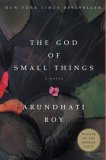Write your own review!
Tami Jean-Claude
The novel had a good plot and I like it how the author used the mind of two seven years olds on it, but I think she used too much imagery in the book and it was too disorganized. I got to know more about the indian culture, and it was very interesting.
monica gellar
the book was pretty good but some parts seem to go on forever. She repeated phrases and words so often it got tiresome. To be honest, i had to force my self through the first few chapters. I was going to give up but was told it would get better. And near the very end, it did. It is written beautifully but some of it is a little over written and got quiet dull. overall its a interesting book with a surprise twist ending.
IreneB
Glad I am not the only one who disliked this novel
I read this for my bookclub and only finished it for that reason. It could have been written in a linear way and been a better story for that. Towards the end if the book I ended up having to reread some earlier chapters because I couldn't fit them into the overall narrative. And like one of your other reviewers, I skimread the final chapters with their awful detail. The only non linear writer worth reading is Lawrence Sterne, who got away with it in Tristam Shandy, but then that was a funny book.
bob
the god of small things...
Roy's "The God of Small Things" is written in a fascinating stylistic way.. However some of the phrases and sentences don't make sense. Arundhati uses metaphors very well to create a realistic picture in our minds, but often they seem to go on for far too long, and finally you come to the point where you can't remember what the meaning of the metaphor was in the first place.
Chris
This emperor has no clothes. While Roy tells many small snippets of story in this novel, she fails utterly to tie them into a narrative whole. I was recommended this book by a friend. She had read it for a class, and apparently they 'had to be built up' to where they could appreciate the novel. Unless you have an instructor or friend helping to describe the 'clothes' to you, or you enjoy unearthing the mundane, minimal plot Roy has buried beneath lush strata of setting and mood, you will not like this book. The reader has to do far too much work that the writer should have done, and the insistent reaching for the next metaphor or stylistic transition between segments becomes highly irritating.
This book is an insult to intelligent readers, and is recommended as a caution to intelligent writers. Style is necessary, but cannot replace substance.
When the most entertaining element of a book is its testicular imagery, there is something wrong.
I am 24 years old.
so-so at best
The book is a prime example of the uselesss trype that is literature today, National Endowment of Arts style drivel much akin to the photo of the cross in a pool of urine. purile at best, why such reliance of human viscus, good imagery and loose prose style. i found it interesting that such great authors praised the book, while literary hacks like will self recognized it for the waste of time it is, the whole time i read it i just wanted to get to the point already. what's the deal with the masturbation scene and the incest scenes, how hackneyed can one get. read a der spiegel interview with roy, absolutely laughable, what mind-numbing crap, spewing ignorant bleeding heart, uniformed liberal nonesense that one would expect from such an ideologue.
yamah
I really didnt get what all the hype was all about. perhaps the media was trying to create another persona that they could sell - a beautiful woman writer from the third world. as for the book, the writing style was a little too contrived. each word had been carefully weighed. i dont deny, that there was a flow in her use of language and the words carry you with ease from beggining to end....but the story essentially left me completely unmoved. at the end of the book, i felt like, god, this was just fluff and feathers. there was nothing new about the ideas in the book to one well aquainted with india - just typical indian scenes and situations. perhaps this book has been deliberately written for the international market.
roy
terrible book
Worst book I have read in a long time, couldn't even finish it. Most parts didn't make sense and it was so wordy it was unbearable.
